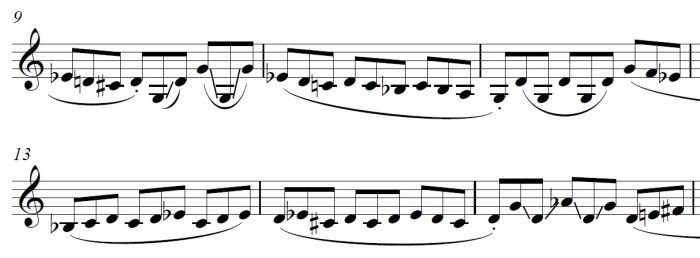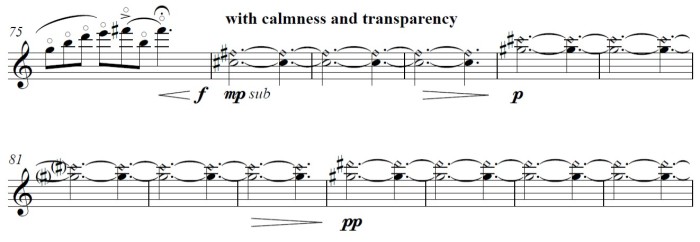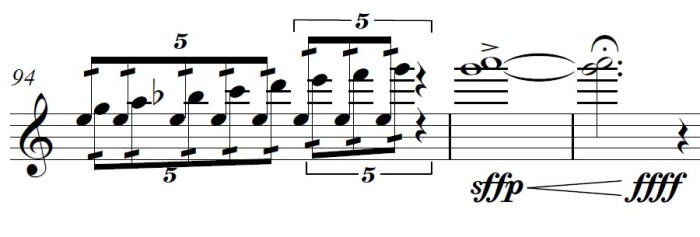This blog concerns Miles upon Miles, a new piece for solo violin written by composer Yao Chen in 2018. I, Patrick Yim, performed the premiere at the Hong Kong Museum of History on Saturday, February 25, 2018.
I would like to offer my sincere thanks to Yao Chen for composing this wonderful work.
This blog is meant to give insight into my process of learning a new work, especially as it relates to the critical way in which I respond to and interpret the markings in the score as I try to ascertain the effects intended by the composer. I hope you will find it insightful!
The piece was composed in three movements:
I. Silk Road
II. Buddhist Mantra
III. Kongfu
Video of Yao Chen: Miles upon Miles (2018), I. Silk Road
I. Silk Road
In this passage, I was unsure of which notes to play in the mordent. Normally I would look to the key signature to determine which notes to play, recognizing that some upper notes would be a half-step above the principal note and some a whole-step above. Given that in this case there would also be an instance in m. 88 of an augmented second (Db to E natural), I thought it would be wise to check with the composer. He noted that the piece is not grounded in any key and therefore he was open to trying different intervals from the principal note. In the end, he decided that a mixture of half-steps, whole-steps, and augmented seconds adds a nice flavor to the passage.

In this passage, I also had questions about which notes to play in the mordent. I found the indication “broadly and expansively” to be very helpful in determining the type of bow stroke to use. I always believe that performers should make decisions about bow strokes, tempo, articulation, vibrato, etc. based on the character of the passage. In this case, I aim to achieve the broad and expansive character by using long, connected and expansive bow strokes.
II. Buddhist Mantra

These sliding passages presented a challenge at first because of the distances and the tempo of the movement. It is not really possible to play the slide for the full interval. Given the quick tempo of the movement, I am only able to give a hint of these slides when I perform these passages. I also found that it was helpful to rest the palm of the left hand against the body of the violin to perform these measures as this method offers stability for the instrument and left hand.

Given the tempo of this passage, I found m. 72 nearly impossible to play. I therefore will play this passage with artificial harmonics in the second position. I think that harmonics found beyond the fingerboard are not the most practical to use on the violin.

The earlier version of this piece did not include the “with calmness and transparency” instruction and as I first started working on this movement, I was not sure what to do with the long notes. I was not sure whether the notes needed direction or shaping. After conveying this concern to the composer, he offered very helpful images to consider. He wrote in an email that these long notes should “let your audience feel they are finally floating in the air very peacefully…Very transparent and light.” I always find it helpful when composers include instructions about character in the score.
III. Kongfu


At first glance, my instinct is to perform this passage with the bow slightly off the string. The composer wanted the passage to be played on the string. Personally, I find it helpful to have instructions such as “on the string” or “off the string.”
I find the tenuto-staccato marking to be a bit ambiguous sometimes. In this case, now that I know to play this passage on the string, I will interpret the marking to mean that those notes should be played slightly shorter (and perhaps with a bit of accentuation) than the surrounding notes that don’t have articulation markings.

I find this effect to be more effective on instruments that have pizzicato sounds that last a long time, such as the cello. On the violin, the decay of the pizzicato is rapid and thus the pitch change can be difficult to perceive. However, given that the glissando notes are written in parentheses, I think that the composer is looking for just a hint of the actual pitch changes.

For the climax in m. 95, I suggested that the major second interval instead be changed to a major ninth interval because as written the string length for the printed G played on the A string is very short and would not allow for a great deal of vibrations by the string. With the G an octave lower, the length of the vibrating string would be much longer and I think more powerful.